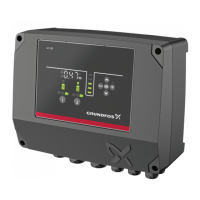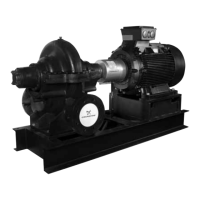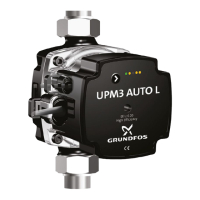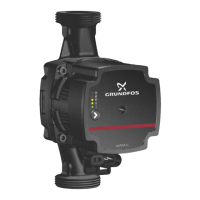English (US)
6
4.3 Securing the base plate
When the raised concrete foundation has been poured and
allowed to set, proceed as follows:
1. Lower the base plate over the anchor bolts and rest it on loose
adjustment wedges or shims placed near each anchor bolt
and at intervals not exceeding 24 in. (610 mm) along each
side.
2. Place the shims or wedges so that they raise the bottom of the
base plate 0.75 - 1.25 in. (20-32 mm) above the foundation,
allowing clearance for grout.
3. Level the pump shaft, flanges, and base plate using a spirit
level, adjusting the wedges or shims, as required.
4. Make sure that the pipes can be aligned to the pump flanges
without placing any strain on either flange.
5. After pump alignment has been established, put nuts on the
anchor bolts and tighten them just enough to keep the base
plate from moving.
6. Construct formwork around the concrete foundation and pour
grout inside the base plate, as shown in fig. 1. The grout will
compensate for uneven foundation, distribute the weight of
the pump, and prevent shifting.
7. Allow at least 24 hours for the grout to set before proceeding
with the pipe connections.
• After the grout has thoroughly hardened, check the foundation
bolts and tighten them if necessary. Recheck the pump
alignment after tightening the foundation bolts.
Fig. 1 Anchor bolt installation
4.4 Mechanical installation
4.4.1 Piping
• Make sure that both the inlet and outlet pipes are
independently supported and properly aligned so that no strain
is transmitted to the pump when flange bolts are tightened.
• Make sure the pipes are as straight as possible, so as to avoid
unnecessary bends and fittings. Where necessary, use 45 ° or
long-sweep 90 ° pipe bends to decrease friction loss.
• Where flanged joints are used, make sure that inside
diameters match properly and that mounting holes are aligned.
• Do not apply force to pipes when making any connections!
4.4.2 Inlet pipe
The inlet pipe must be installed in a manner that minimizes
pressure loss and permits sufficient liquid flow into the pump
during starting and operation.
Observe the following precautions when installing the inlet pipe:
Fig. 2 Inlet pipe
• Run the inlet pipe as direct as possible, and ideally, make sure
the length is at least ten times the pipe diameter. A short inlet
pipe can be the same diameter as the inlet port. A long inlet
pipe must be one or two sizes larger than the inlet port,
depending on the length, and with a reducer between the pipe
and the inlet port.
• Use an eccentric reducer, with the tapered side down. See fig.
2.
LCS pumps do not require alignment or grouting.
Use an approved, non-shrinking grout.
TM 05 4775 2512
Finished grouting
0.75 - 1.25 in.
(20-32 mm)
allowance for
grout
Formwork
Pipe sleeve
Washer
Base plate
Grout
Wedges or
shims left in
place
Top foundation
Lug
Do not let the pump support the pipes. Use pipe
hangers or other supports at proper intervals to
provide pipe support near the pump.
TM05 4791 2613
Concentric reducer
Eccentric reducer
Tapered side is down
Air pocket
Correct
Wrong
LC_LCV_LF_LCS_1 language_US Eng.book Page 6 Thursday, August 24, 2017 4:08 PM
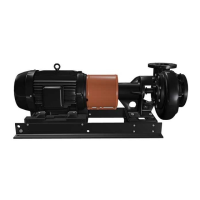
